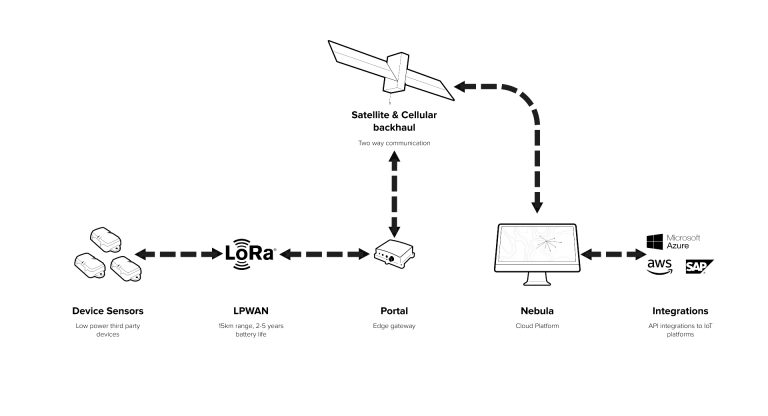- Nvidia aims to bring AI to wireless
- Anthropic's new AI models for classified info are already in use by US gov
- My cat loves this automatic wet food feeder, and it's on sale
- Certified and Unstoppable: Recertify with Rev Up
- Walmart's drone delivery spreads its wings to 100 more stores - is yours one?
Women Rock-IT, or Rock-ET? Australian rocket scientist connects Earth’s framework from space – Cisco Blogs

This blog post comes from Flavia Tata Nardini, an Australian-based rocket scientist, CEO of Fleet Space, and the Mission Chair of the Seven Sisters Moon Mission, who has launched six nanosatellites into Low Earth Orbit to help power the Internet of Things. Learn how Flavia uses her STEM knowledge in space at Cisco’s upcoming Women Rock-IT broadcast on July 15th.
I am on a mission to change Earth from Space. My goal is to embrace the Fourth Industrial Revolution by creating a digital nervous system with Fleet Space, that will connect every single device on our planet through a constellation of 140 nanosatellites we are building and launching over the next few years. This is set to maximize the resource efficiency of human civilization through low-cost, low-power, and remote massive IoT.
Pushing boundaries and creating something new
But I also want to push the limits of Earth and apply the best of Australian space, remote operations, and exploration to develop innovative, non-invasive, super-scalable exploration tools for use beyond our planet, with the goal to enable humanity’s exploration and settlement of new worlds. As Mission Chair of the Seven Sisters Moon Mission, I will lead our mission of discovery for Earth, the Moon, and Mars in 2023.
Fleet Space exists to connect everything. It is estimated that in four years, there will be 75 billion devices across the globe, all needing an Internet connection. Yet with our current 3G, 4G, and 5G networks, these only connect approximately 40 percent of the global population, with huge gaps in connectivity in remote and rural settings. The complexity across the connectivity ecosystem paired with the lack of integrated and scalable future-focused solutions, led us to look to space for a viable solution. Fleet Space’s reliable connectivity solution can provide Internet connectivity across the whole globe to better support remote operations, such as critical infrastructure and mining.

Optimizing IoT for space
So how on Earth (pun intended) does a space company support businesses to optimize their rurally dispersed assets? Our technology improves alert response time, longevity of assets, and ultimately, enhanced operation.
Applying this technology solution allows, for example, power utilities to monitor their wide-spread asset base remotely and effectively, which demands continual maintenance and repair to prevent equipment failures and outages, as well as keeping the system and employees operating safely. The ‘always-on’ vision of a remotely monitored network provides a solution that can greatly reduce the need to manually check equipment by driving a truck to a site, which is one of the biggest expenses that utilities have, or to quickly locate exactly where a fault has occurred, saving precious time in restoring power to customers.
With the challenge of keeping costs under control and service reliability high, knowing how to reduce response time from hours to minutes and prioritizing network maintenance and repairs to provide the most efficient and cost-effective results can set the bar for any utility to become an industry leader. Remote monitoring of assets is fast becoming the new normal for many utility companies, and change leaders in the industry are making IoT an intrinsic part of operations and maintenance activities.
The challenge of accessibility to these distributed linear assets, which span thousands of kilometers, has paved the way for Low-Power Wide Area Network (LPWAN) technology, which requires long-range communication, and uses the open stack LoRa data transmission protocol to achieve these needs. LoRA is the radio wave signal that the data is sent across from an IoT sensor to its receiving node, with typical coverage ranging up to 20–25 km in rural environments. These capabilities make this IoT technology perfect for geographically dispersed assets.

Our unique approach to satellite technology
At Fleet Space, we have developed a service that collects customer data from multiple sensors into a terrestrial network of Portal gateways. Each client’s Portal operates as a receiver, while the transmitter, by incorporating edge computing capability, performs processing and data compression “at the edge” prior to transmission through the satellites. These ground networks are often likened to being like IoT brains in the field, and makes for both a smart and cost-efficient transmission of data via the Fleet Space constellation. The collected data then lands in a secure cloud network management system, called Nebula, a mission control center that then seamlessly pushes the data, alerts, and actions by API through to the client’s preferred software OT system.

Our nanosatellites, that are roughly the size of a shoebox, provide coverage across the globe, and our patented beam-forming technology means we can build nanosatellites that are 10x more powerful than other satellites their size.
Living in an age of realized dreams
We are now living in a commercial space age that is changing how we do things on Earth. We are expanding operations to transform industries through our technology. Our unique combination of global connectivity, edge computing, and a multitude of new data points has the potential to unlock billions of dollars of value in critical industries and resource sectors. With space being the next frontier for industries across the globe, the future of connected devices will enable businesses to look to the stars to solve the world’s future challenges across essential utility networks.
Since I was a little girl, I was determined to make a change in this world using space technologies. My dreams are coming true … and the potential of today’s students can become reality through STEM education. My mission has been accomplished by inspiring today’s young generation through my work of launching satellites into space using math and science.
Share:

